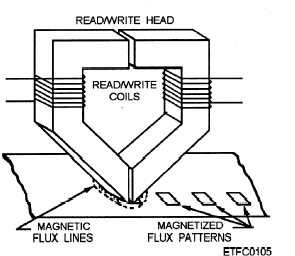head or group of read/write heads. The moving tape can
then have data written upon it as is shown in figure 9-9.
Data may be read from tapes having information stored
on them.
Each individual write head can store data one bit at
a time along an invisible line on the tape called a track.
The number of bits written per inch of track (bpi) is one
of the factors used to determine the density of data on
the tape. An industry standard 0.5-inch tape may have
seven or nine tracks of data stored on it.
Data Organization and Timing
The read/write heads of magnetic tape devices are
usually designed to write and read data concurrently
across the width of the tape. This grouping of bits is
known as a frame. On multitrack tapes, density is
determined by the number of frames per inch (fpi)
instead of bpi for a single track. Common densities for
multitrack tapes range from 200 to 1,600 fpi. Most
magnetic tape devices are capable of writing and
reading several different fpi densities.
A frame of data on a seven-track tape consists of
six data bits, and a check (parity) bit. A nine-track
frame has eight data bits, and a parity bit.
Frames are determinedby the a shift of the magnetic
field in any bit position within the frame. With the
proper combination of parity checking (odd parity) and
data, at least a single binary ONE is stored in each
frame. Using the NRZ recording method, every frame
contains at least a single binary ONE. The presence of
a ONE, when detected by any read head, will indicate
the presence of a frame.
This recording method is
known as non-return-to-zero indiscrete (NRZI).
Magnetic Tape Markings
Magnetic tapes have many common features and
data recording formats. Each tape is marked, in some
manner, at beginning of tape (BOT) and at end of tape
Figure 9-9.—Writing data on magnetic tape.
Figure 9-10.—A magnetic tape layout
9-8



